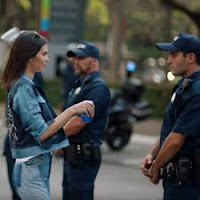Semiotics: blog tasks
1) What meanings are the audience encouraged to take about the two main characters from the opening of the film?
From the start of the film the audience is made to think and stereotype the character (the one with the fur hat) because of the tracksuit and big jacket he is wearing which signifies with antisocial behaviour and intimidation. From the characters body language and camera movement we'll able to suggest that he might try to rob her as he puts his good up and has a firm facial expression but as the woman gets into her car he picks up something she drops. As the first character picks up the harmonica and gives it to the second character he decides to play it but there is a homeless man trying to sleep and told the second character multiple times to stop playing. This connotes the usual stereotype that all young people are disobedient and that he's not emphatic towards the homeless man trying to sleep.
2) How does the end of the film emphasise de Saussure’s belief that signs are polysemic – open to interpretation or more than one meaning?
The end of the film enforces de Saussure belief that signs are polysemic because we later understand that characters English and johst are deaf and communicate through BSL this really tackles the unconscious bias and explains their actions in a different way. Another way in which the end of the film connotes the clear understanding of De saussures idea is through the way he character build up a disliking from the audience which then is broken for the good intention i.e when they took the homeless mans old banana to get him a fresh and eatable pack.
Media Magazine theory drop: Semiotics
1) What did Ferdinand de Saussure suggest are the two parts that make up a sign?
The first part would be 'The signified' - which is the thing which is communicated.
The second would be the 'the signifier' - which is the thing that does the communication.
2) What does ‘polysemy’ mean?
Its the sign that be interpreted as many or multiple meanings and is open to understanding.
3) What does Barthes mean when he suggests signs can become ‘naturalised’?
This means that something has been socially accepted as we've become used to the idea and the connations it holds.
4) What are Barthes’ 5 narrative codes?
The first one would be 'enigma code' - this is something unexplained or mysterious to get the audience or reader asking questions to intrigue them.
The second one would be 'action code' - this is something that refers the audience something is going to happen like a jump scare as the camera pans around a dark room.
the third one would be 'semantic code' - this creates a deeper meaning in the text or scene.
the fourth one would be'symbolic code' - can be used to describe anything to give it a deeper inference.
the fifth one would be 'cultural code' - this is when something has fact or 'external body of knowledge'.
Icons, indexes and symbols
1) Find two examples for each: icon, index and symbol. Provide images or links.
Icon: Ice caps melting the arctic.
Index: The artic is getting hotter due to global warming.
Symbol: a ice melting with water around it.
second example of each: icon, index and symbol. Provide images or links.
Icon: A baby crying.
Index: suggests it either hungry or wants to sleep.
Symbol: a baby with a sad or scrunch face.
2) Why are icons and indexes so important in media texts?
There important because they create build an understand but also question our socially constructed connotations about certain things.
3) Why might global brands try and avoid symbols in their advertising and marketing?
because not everyone understand it as its something you culturally understand like language so if you try to translate it could lose its meaning.
4) Find an example of a media text (e.g. advert) where the producer has accidentally communicated the wrong meaning using icons, indexes or symbols. Why did the media product fail? (This web feature on bad ads and marketing fails provides some compelling examples).
This advert failed because it mocked a social movement which caused a lot of controversy
 as police brutality was at its highest peak and people were really worried as how it could affect minorities.
as police brutality was at its highest peak and people were really worried as how it could affect minorities.5) Find an example of a media text (e.g. advert) that successfully uses icons or indexes to create a message that can be easily understood across the world.
A successful advert that uses icon and index to create a good and understandable message is Snapchat as they use there ads to address concerns about software their customers had this was a great example if a good advert using icons as it interacted with their audiences and used images to advertise things that catered to them personally.

Comments
Post a Comment